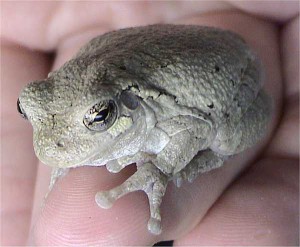Ever since a colleague introduced me to the Spadefoot Toad and the practice of monitoring frog and toad calls during the summer months as one way of tracking the prevalence and health of frogs and toad populations over time, I have been intrigued by any research on frog and toad calling. So, when I saw news headlines about “multitasking” Copes grey treefrogs (Hyla chrysocelis) and their “popularity” among the females of their species, I couldn’t resist.
The paper, published in Animal Behaviour by Ward and colleagues describes an investigation of the predictions of the “multitasking hypothesis”. Briefly this hypothesis predicts two things. The first prediction states that when you have a signal that has components that negatively covary (in order for one component to occur the second one is reduced), say pitch and volume, there will be a tradeoff between the two things (e.g., I can sing at a really high pitch, but not very loudly). The second prediction is that the individual on the receiving end of this signal is going to prefer the individual who can do both at the same time (e.g., sing at a really high pitch, very loudly). In this study, the authors looked at female frog choice based on three factors: call rate (the number of calls per minute), call duration (number of pulses per call) and call effort (calls/min x pulses/call = pulses/min). They asked two questions: Is there a tradeoff between rate and duration, and do female frogs prefer the male frogs that exhibit the higher overall “call efforts”?
Now, in my limited experience listening to frog and toad calls, the Copes grey treefrog has always seemed like a species of frog that was into “extreme” frog calling anyway. They have a very loud, penetrating call, and, frequently when call boxes were employed in some of the field studies that I helped with, the Copes grey treefrogs seemed to position themselves directly under the microphone in the call box, as if they were trying to seduce the researchers who would analyze the tapes back in the lab. You can listen to a Copes grey tree frog call here.
The study was conducted in a laboratory using recordings of Copes grey treefrogs made in east-central Minnesota. Twenty recordings were made from 50 calling males. They analyzed the recordings for each male and used linear regression analysis to test the hypothesis that call duration and call rate negatively covary. Their results indicated that males that called at faster rates produced shorter calls. They found that for all fifty males recorded, call rate and call duration were significantly negatively related. When they looked at call rate and call duration, they found a positive relationship, but no relationship was observed between call duration and call effort.
To test the hypothesis that female frogs prefer the greater call effort but would show no preference between call duration or call rate the researchers used a phonotaxis test, in which female frogs were placed in a release cage in the center of a test arena and presented calls that reflected a different combination of characteristics based on call rate, call duration and/or call effort, Female choice was scored based on movement of the female toward a speaker broadcasting a specific call. For this study, female frogs in amplexus were collected from the same field sites from which the recordings of the males had been made. Calls were tested against a silent background and in a background of chorus noise.
Their analyses indicated that females preferred both higher call rate and longer call duration, but that this preference was actually based on call effort. However although some laboratory testing indicates that males will adjust call rate or duration in response to a competitive environment, males do not increase overall call effort due to competition in these conditions. So maybe making themselves “attractive” to females is not the only function of the Copes grey treefrog call. Perhaps there is something else going on as well.
Reference
Ward J.L., Love E.K., Vélez A., Buerkle N.P., O’Bryan L.R. & Bee M.A. (2013). Multitasking males and multiplicative females: dynamic signalling and receiver preferences in Cope’s grey treefrog, Animal Behaviour, 86 (2) 231-243. DOI: 10.1016/j.anbehav.2013.05.016
Michele Arduengo
Latest posts by Michele Arduengo (see all)
- An Unexpected Role for RNA Methylation in Mitosis Leads to New Understanding of Neurodevelopmental Disorders - March 27, 2025
- Unlocking the Secrets of ADP-Ribosylation with Arg-C Ultra Protease, a Key Enzyme for Studying Ester-Linked Protein Modifications - November 13, 2024
- Exploring the Respiratory Virus Landscape: Pre-Pandemic Data and Pandemic Preparedness - October 29, 2024


My Chase likes to catch frogs or toads…..